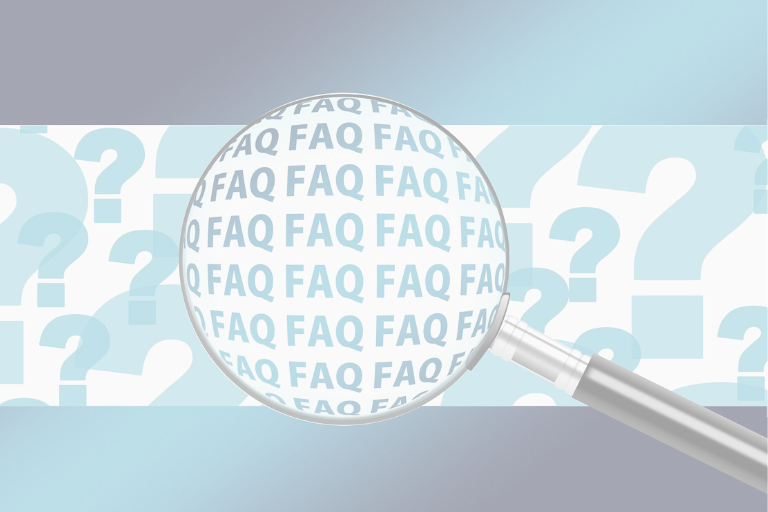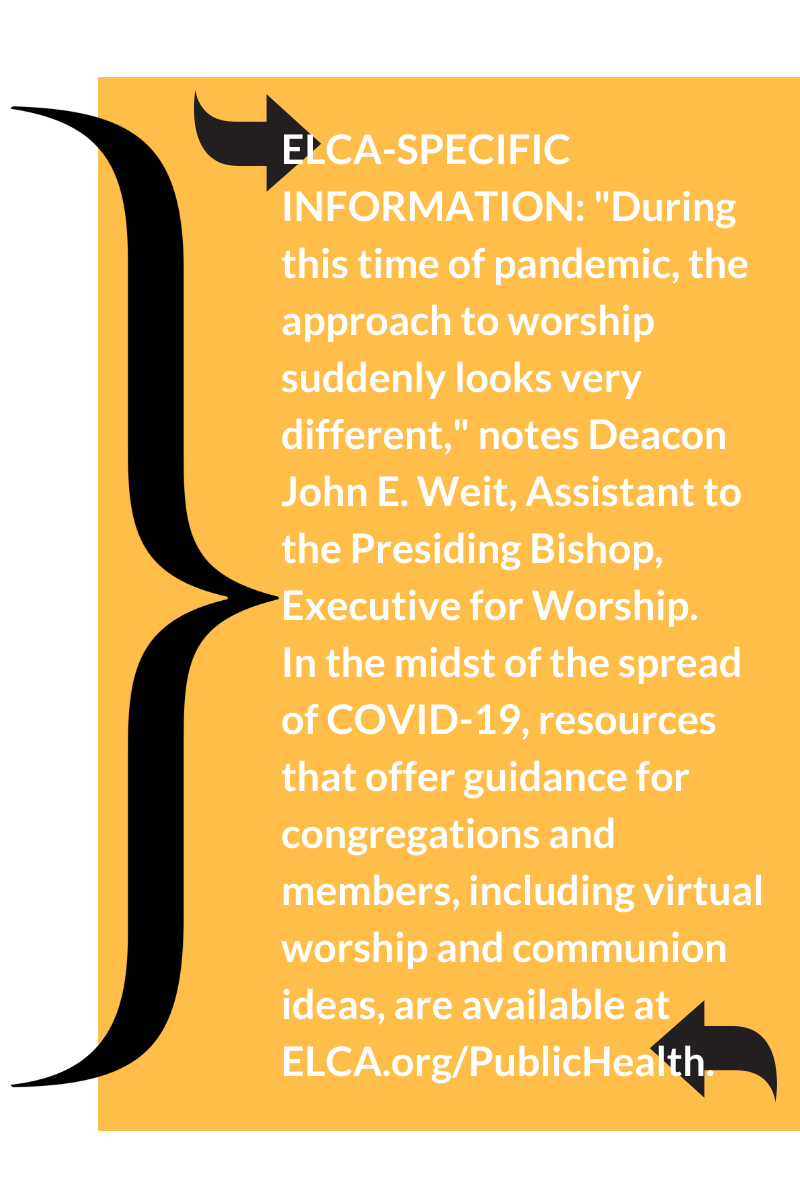 Guidance updated on March 27, 2020, was shared through the coronavirus for faith leaders White House briefing network. ELCA Advocacy staff participate in the opportunity for access to public health experts and Centers for Disease Control and Prevention advice for religious communities.
Guidance updated on March 27, 2020, was shared through the coronavirus for faith leaders White House briefing network. ELCA Advocacy staff participate in the opportunity for access to public health experts and Centers for Disease Control and Prevention advice for religious communities.
ORIGINAL INTRODUCTORY NOTE: The following recommended preventative practices and answers are in response to common questions [DHHS Partnership Center has] received and are based on what is currently known about the Novel Coronavirus Disease 2019 (COVID-19). Should you have questions not listed below, please contact the Partnership Center:partnerships@hhs.govor 202-260-6501. We will do our best to respond in a timely fashionand will continue to update this document as further questions and information come to our attention.
Frequently Asked Questions (section reprinted from DHHS Partnership Center resource)
-
What Are the Signs and Symptoms of COVID-19?
Reported illnesses have ranged from mild symptoms to severe illness and death for confirmed COVID-19 cases. The following symptoms may appear 2–14 days after exposure:
-
-
- Fever
- Cough
- Shortness of breath
-
-
Should We Have a Gathering at All? How Close Does an Infection Need to Be to Our Community to Consider Cancelling Our Gathering?
The President’s Coronavirus for America recommends avoiding social gatherings of 10 or more people. Check with your state and local health authorities for the latest information. Public health officials may ask you to modify, postpone, or cancel events if it is necessary to limit exposure to COVID-19. Be mindful of the vulnerable members of your community and seek to protect them from exposure to other people.
Review “Implementation of Mitigation Strategies for Communities with Local COVID-19 Transmission.”
Use the CDC’s Guidance on Mass Gatherings as a guide for reviewing your community’s calendar and to make decisions on which events may need to be canceled and by when.
Track efforts by the federal government, the following websites have been launched:
-
-
- English: www.USA.gov/Coronavirus
- Spanish: https://gobierno.USA.gov/Coronavirus
-
Practice social distancing however possible ― staying at least six feet away from other persons.
Review the “Interim Guidance for Administrators and Leaders of Community- and Faith-Based Organizations to Plan, Prepare, and Respond to Coronavirus Disease 2019 (COVID-19)” for best practices.
At this time, community members should not hug or touch one another, but offer hand signals like a peace sign or the American Sign Language sign for “I Love You.”
Greeters at all gatherings should be especially aware and refrain from offering handshakes. As one community noted, “Greeters can model hospitality with their words and their smiles.”
-
What Should I Tell People Who Are Concerned?
Reassure them that your faith- or community-based organization, as well as local, state, and national authorities, is taking all necessary precautions to ensure their health and safety. Your response can soothe concerns and create an atmosphere of calm. The best way to prevent illness is to practice routine and common sense hygiene practices. These everyday practices also help to prevent the spread of respiratory diseases, including the flu:
-
-
- Stay home when you are sick, except to get medical care.
- Cover your coughs and sneezes with a tissue and then throw the used tissue in the trash.
- Wash your hands often with soap and water for at least 20 seconds, especially
after going to the bathroom; before eating; and after blowing your nose, coughing,
or sneezing. If soap and water are not readily available, use a hand sanitizer that contains at least 60% alcohol. - Avoid touching your face with unwashed hands, especially your eyes, nose, or mouth.
- Clean high-contact surfaces and objects thoroughly and repeatedly.
-
Leaders may find it helpful to review the guidance provided by the CDC in its “Interim Guidance: Get Your Community- and Faith-Based Organizations Ready for Coronavirus Disease 2019 (COVID-19).”
Check with your state and local health authorities to learn if your community has experienced a COVID-19 outbreak.
-
How Can We Advise the Elderly, Those with Special Health Considerations, Their Caregivers, and Other High-Risk Populations?
Provide special consideration in communicating risk to vulnerable populations in your community, including older adults and others with access and/or functional needs. Assign, or encourage those whom you serve to seek out, a “buddy” who will check in on and help care for them, should they get sick.
Make plans to stay connected.
-
-
- Ensure community contact lists are up-to-date and that ‘calling trees’ ― or other practices to account for individuals who may be living alone, elderly, and vulnerable ― are in place.
- Convey ways they can stay connected via virtual worship, gatherings, and staff and leadership meetings.
- Ensure there are clear means to communicate any “connection plans” with them.
-
-
What Should I Do if Someone at a Community Gathering Says They Are Feeling Sick?
Identify space in your facility or event to separate people who may become sick and may not be able to leave immediately.
Designate a separate bathroom for those who are feeling sick. Develop a safe plan for cleaning the room regularly.
Isolate the individual immediately from staff and participants.
Assist the person in CALLING AHEAD to their health care professional if they have a fever and symptoms of respiratory illness, such as cough or difficulty breathing. Tell them to avoid taking public transportation, ride-shares, and taxis.
People with confirmed COVID-19, with a loved one in the home with a confirmed case, or those experiencing symptoms should remain under home isolation. The decision to discontinue home isolation precautions should be made on a case-by-case basis, in consultation with health care providers and state and local health departments.
For more information: https://www.cdc.gov/coronavirus/2019-ncov/if-you-are-sick/.
-
Is Information About COVID-19 Available In Spanish?
The following website provides a wide range of information on COVID-19 in Spanish: www.cdc.gov/coronavirus/2019-ncov/index-sp.html
Los Centros para el Control y la Prevención de Enfermedades (CDC) tienen información en español sobre COVID-19 en su sitio web en www.cdc.gov/coronavirus/2019-ncov/index-sp.html
-
Does the Virus Live on Surfaces?
COVID-19 is a new disease and experts are still learning how it spreads. It may be possible to be exposed to COVID-19 by touching a surface or object that has the virus on it and then touching your mouth, nose, or eyes; however, this is not thought to be the main way the virus spreads. Review the CDC’s “How COVID-19 Spreads.”
Clean frequently touched surfaces and objects several times daily (e.g., tables, countertops, light switches, doorknobs, cabinet handles, smart phones, and keyboards) using an appropriate cleaner to minimize the event of a COVID-19 outbreak in your community. For disinfection, most common EPA-registered household disinfectants should be effective. A list of products that are EPA-approved for use against the virus that causes COVID-19 is available here. Follow the manufacturer’s instructions for all cleaning and disinfection products.
If an object is frequently touched, for example as a part of religious observance, it should be cleaned, as appropriate within the religious tradition, after each use.
If surfaces are dirty, they should be cleaned using a detergent and water prior to disinfection.
For the future, consider ways your community can reduce the number of objects that are collectively handled.
-
-
- For example, consider no longer passing offering plates down the row; instead, place the offering plate on stands and ask people to leave their offering. Remind those who oversee and administer offerings, or similar items and elements, to wash their hands after administration or use.
- Organizations may also consider removing shared books and encouraging people to bring their own.
-
-
What Type of Items Should We Have in Our Emergency Preparedness Kit?
Consider having supplies on hand, such as hand sanitizer that contains at least 60% alcohol, extra tissues, and trash baskets.
Refer to the CDC’s “Preventing COVID-19 Spread in Communities” for additional information about supplies and materials.

